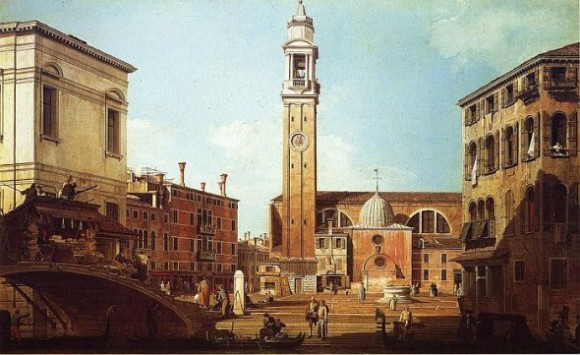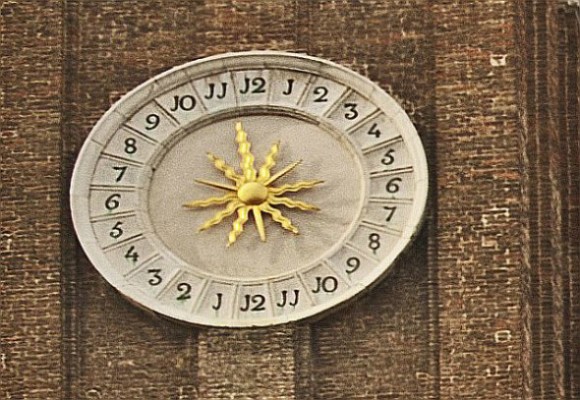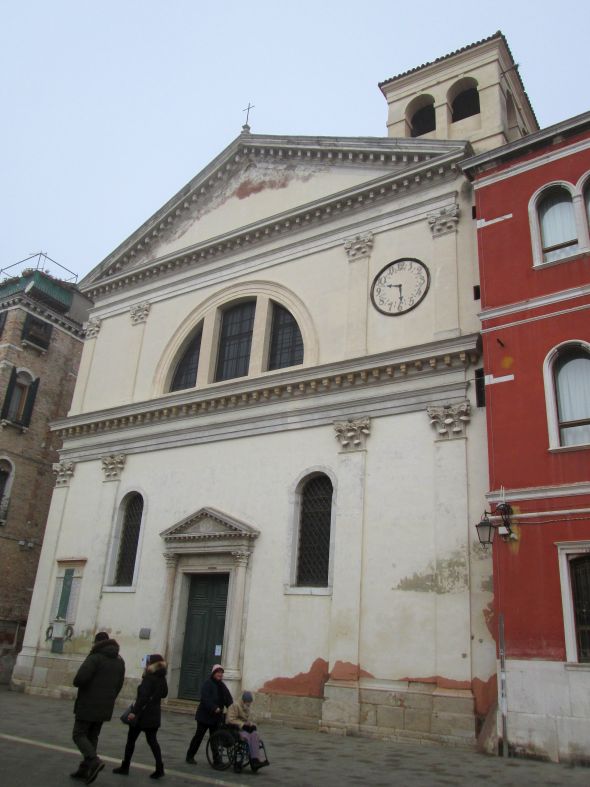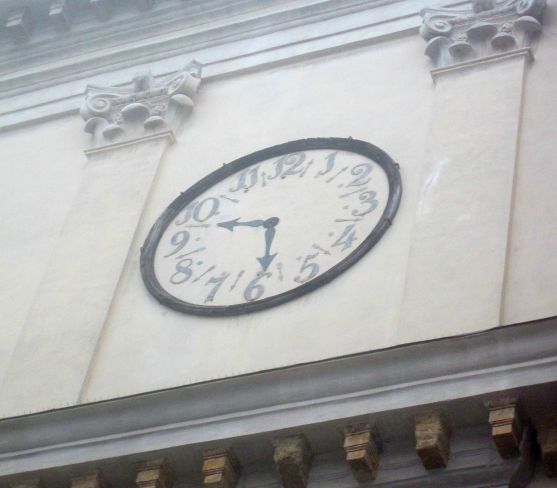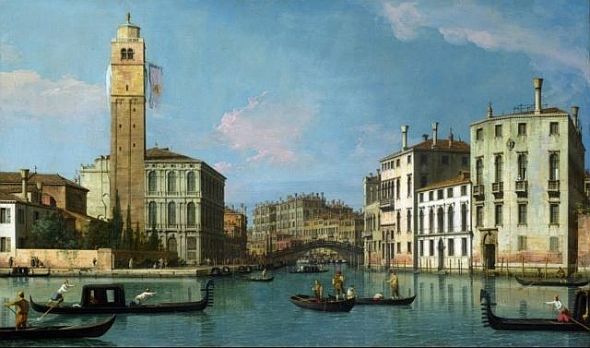
Before wristwatches, there were bells, usually in towers. But for the bells to be useful, somebody had to know what time it was, so a clock needed to be lurking somewhere — preferably attached to the bells. Of course, clocks didn’t have to have bells. But bells were irrelevant without a clock.
So if ingenuity appeals to you, I suggest you go to the church of S. Geremia, near the train station, to observe one of the oldest clocks in Europe; it is the still-functioning mechanism that kept their two bells ringing — with a 70-year interlude — ever since the 1500’s. (No, there doesn’t seem to be a definite date to the clock’s arrival; I have turned the booklet’s information inside and out, and now it’s my brain that feels like a piece of origami. So “1500’s” will have to do for now.)
(For those whose minds can never be at rest, let me add that the first public clock in Italy was installed in the tower of the church of Sant’ Eustorgio in Milan between 1297 and 1306.) (I will not be reporting anything about Sant’ Eustorgio.)
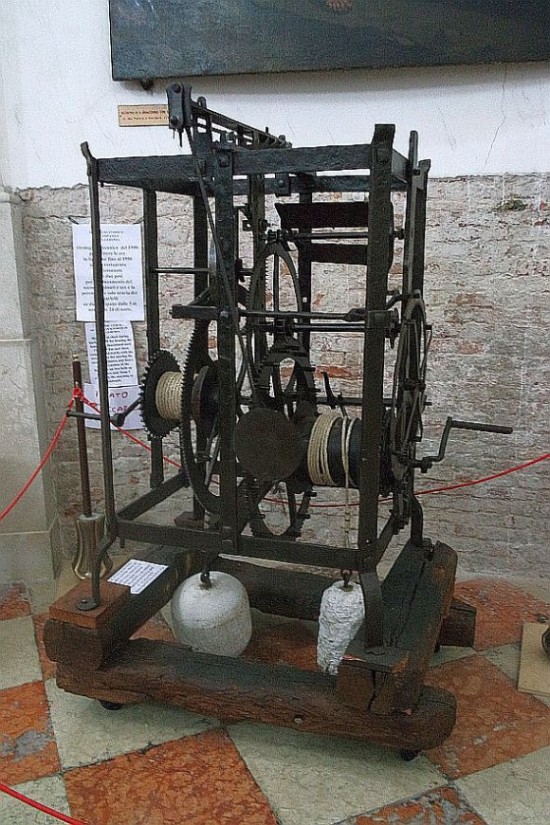
The tower of S. Geremia has a clock, but no clock-face. In fact, only a few churches in Venice whose bells still alert us to the time also display a visible clock. Clock-faces became common in the 1500’s, the result of I don’t know what impulse, because when you think about it, the striking bells told you everything you needed to know without a visual aid. The belltower of the church of the Carmini, whose bells told me the time for the ten years I lived nearby, has no clock face. I never thought about that till this moment. Just hearing the hour and quarter-hour struck was enough to keep me oriented over the course of the day (and night). But because somebody had to know exactly what time it was, there was a sundial, still visible, on the tower of S. Geremia, which enabled this person to calibrate the works, by hand, exactly at noon. I’ll explain the importance of that in a minute (sorry).
This mechanism is probably one of the simplest, but it still impresses the hoo out of me. Not being literate in the language of wheels — cog, fly, escape, Catherine — I’m not convinced that it was made by an engineer and not by an alchemist or general all-purpose thaumaturge. The important point is that it was maintained in working order till 1950. At that point it went into retirement, until a restoration project brought it back to life in 2015.


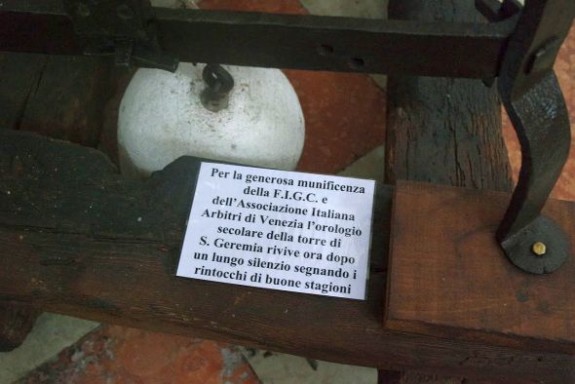
Venice was a city of towers and there were many more than there are today. In 1601, a certain Franz Schott, writing a guidebook entitled “Itinerario d’Italia,” stated that Venice contained 27 public clocks, and “towers for church bells 114.” Today, there are 84. We can thank Napoleon for this devastation.
Schott, being German, made those useful distinctions because they weren’t all clock-towers — some were watchtowers, or signal towers, or showing-off towers built by especially rich people.
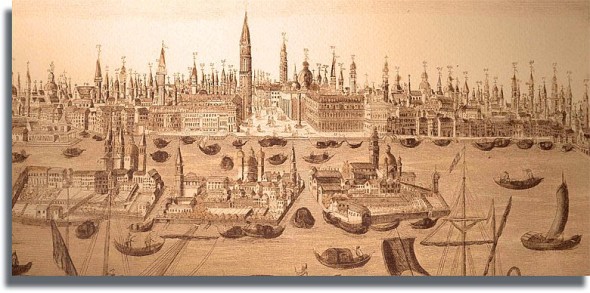
The need for clocks (have you never reflected on why there was a need for clocks?) seems to have begun in the Benedictine monasteries, to ensure the correct timing of the Liturgy of the Hours throughout the day — and night. But there was also a need for order in arranging the day’s activities out in the profane world, so people got used to organizing themselves according to the bells rung for religious purposes.
Here is how a typical medieval day in Venice rolled along, at least until the 1500’s, from the comprehensive booklet written by Francesco Zane (translated by me):
“Until the 1600’s the devout custom continued of following the divine offices during the night, and the doge never missed attending in his chapel, just as the Greek emperors (I presume he means Byzantine emperors) and the French and Longobard kings. (The “divine offices during the night” would have occurred at midnight and 3:00 AM. No wonder he dozed off in meetings.)
“As the sun rose behind the campanile of San Marco, at the sound of a bell each person got busy working, and seeing that the most numerous artisans were the carpenters, in Venice called marangoni, they named that bell the Marangona. The magistrates seated and the workshops already buzzing, not a few patricians … gathered at Rialto beneath the porticoes, which are to the right as you descend the bridge, for the sole purpose of seeing each other and talking together, while at the same hour and in the remaining porticoes (was) a crowd of merchants — Florentine, Genoese, Lombards, Spanish, Saracens, and of whatever nation of the world was involved in major business. They stayed there till noon, when it was time for lunch.
“…lunchtime was brief, only half an hour after noon had struck, when another bell … struck for a half hour calling everyone back to work, so that the entire time allowed for the pause was only one hour. When night fell, work and public business necessarily ended, but it wasn’t unusual whenever and where it was requested or needed that the magistrates would continue to work on state business.
If you’ve ever noticed the bell ringing every day at 2:00 PM from the campanile of San Marco, that was the signal ending the lunch break for the Arsenal workers.
“Finally, at the third hour of the night (Compline, or 9:00 PM), another bell was rung … after which you could no longer walk around the city … nor could you keep fires burning in shops and houses on pain of a fine of 100 soldi, by which provision the habitations, which were, for the main part, of wood, were preserved from fire. But in the 1400’s it was permitted for barbers and small food shops to remain open after “terza della notte” (6:00 PM).
All these are times that correspond to the canonical hours, which persisted till the 1700’s. Slightly confusing, because the day was considered to begin at sunset. “Prime” was 6:00 AM, “Terza” was 9:00 AM, “Sesta” was 12:00 PM, and “Nona” was 3:00 PM. Documents often refer to meetings and other events as occuring before or at or after a certain named bell. Everybody knew what “Nona” meant, just as I’ve gotten used to knowing what “Candelora” and “l’Immacolata” mean in terms of dates.

It fell to the bells to keep a city of 100,000 people functioning efficiently; the Venetian government needed to ensure that everybody knew what time it was, and S. Geremia was one of four churches which officially sounded the time for any governmental meeting, especially the Great Council. (The other official churches were the Frari, San Francesco della Vigna, and, of course, San Marco, all the highest towers in Venice and all necessarily synchronized, which is where the sundials came in.) Seeing that the Council numbered some 2,000 members who lived all over the city, these four strategically placed belltowers totally removed any chance for someone to arrive late saying he hadn’t heard the summons. Being sure of a standard citywide time enabled the office timekeeper to define what “showing up late” meant, which made it easy to impose the appropriate fine.
Out in the parishes, when the bells rang for Prime (dawn) every morning, the appointed persons would open the thousands of public wells, which had been covered at night. (Reports of the occasional suicide make it clear why this was desirable.) This practice was maintained, perhaps toward the end without the bells, until the acqueduct from the mainland was built in 1884.
Also at Prime, every day from 1516 to 1797, the bells from S. Geremia signaled the guards to open the gates to the Ghetto. At the bell of 6:00 PM the gates were closed and bolted, and the night patrol began its circuit — in boats, naturally — of the walls of the Ghetto.
Who paid for this clock? S. Geremia didn’t have a monastery to justify or fund it; its use was entirely secular, and the parishioners paid for it. San Geremia was one of the largest parishes in Venice, and by the late 1200’s had developed both economically and socially well beyond its poor, marshy beginnings. There were many businesses which depended on knowing what time it was — for example, the foundries.
The city’s oldest foundries were in the parish of S. Geremia, in the area which later was assigned to the Ghetto. The period between the 13th and 14th centuries saw rapid innovations throughout Europe, and one writer says that it was no coincidence that the first artillery and clocks began to appear at the same time. Among other things, the Venetian foundries cast bombards, or early cannon, as well as creating the alloys used for other assorted weapons. Foundry workers were required to live in the parish. I give this as a fact, though I can’t provide the reason, except for the fact that virtually everyone resided near their place of work.
To return to the clock: There are signs that it was cast by the “Dondi” foundry. Several generations of Dondis distinguished themselves in the realm of timepieces. Clock people (of whom I am not one; I’m just passing through) venerate the name of Giovanni Dondi Dall’ Orologio (“of the clock”), who in 1364 completed work on his Astrarium, a complex astronomical clock which one source calls “one of the most important machines of all time.”
To sum up: Artisans and engineers at the pinnacle of their skill collaborated to make this sturdy, unstoppable instrument. I have no doubt that they looked upon it and saw that it was good, though they might not have imagined it would keep going for 500 years. That’s a heck of a lot of TOCKs.
